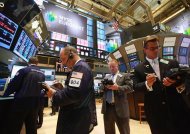RELATED QUOTES
| Symbol | Price | Change |
|---|---|---|
| ^DJI | 13,169.43 | -38.52 |
| ^IXIC | 3,022.52 | 1.66 |
| ^RUT | 799.49 | -2.06 |
| ^GSPC | 1,404.10999 | -1.76 |
| FSII | 6.16 | 2.12 |
RELATED CONTENT
 View PhotoTraders work on the floor of the New York Stock Exchange, August 8, 2012. REUTERS/Brendan McDermid
View PhotoTraders work on the floor of the New York Stock Exchange, August 8, 2012. REUTERS/Brendan McDermid
By Angela Moon
NEW YORK (Reuters) - Stocks ended slightly lower on Monday as fatigue set in after a six-day rally and disappointing Japanese growth data provided a fresh reminder of the headwinds facing the global economy.
The benchmark S&P 500 index had risen 3 percent over the prior six sessions, its longest rally since December 2010. But gains had slowed, with the index hovering at highs not seen since May. The S&P 500 was still up 1.8 percent for the month.
Stocks have been buoyed by expectations central banks would step in soon to support the flagging global recovery and roll back the euro zone debt crisis.
Much of the action, however, is unlikely before September, when the Federal Reserve and European Central bank next hold policy meetings, leaving markets in a holding pattern until then.
"Coming off the heels of a light week on the economic front, the markets remain in what some have called a state of 'melting up.' Whether the market's strength is artificially induced or not, the greater risk for traders at the moment is in missing out on the upside," said Randy Frederick, managing director of Active Trading & Derivatives at Charles Schwab.
With "the European Central Bank, the U.S. Federal Reserve and the People's Bank of China all standing in the wings ready to take action to support their respective economies, the downside risks in the market have been greatly reduced at the moment," he added.
The CBOE VIX Volatility index (.VIX), seen as a proxy for investors' fears, fell more than 7 percent to 13.70, its lowest level in over five years. The decline was unusual as the index typically moves inversely to the S&P 500, suggesting investors were not overly concerned about the market's outlook.
"Bullish sentiment in equities remains high with S&P 500 1-month call-side skew now at the 98th percentile," said Credit Suisse equity derivatives strategy team.
A skew refers to the balance between options betting on the S&P 500 falling - puts - or rising - calls.
The Dow Jones industrial average (^DJI) ended down 38.52 points, or 0.29 percent, at 13,169.43. The Standard & Poor's 500 Index (^GSPC) was down 1.76 points, or 0.13 percent, at 1,404.11. The Nasdaq Composite Index (^IXIC) was up 1.66 points, or 0.05 percent, at 3,022.52.
Japan's gross domestic product expanded just 0.3 percent in the April-June period, half the expected pace, raising doubts about the strength of the recovery and highlighting the impact of Europe's debt crisis on worldwide demand.
Late on Friday, the head of the San Francisco Federal Reserve said the Fed should launch a fresh round of bond buying to lower the U.S. unemployment rate more quickly, fueling speculation that the central bank could soon unveil a new round of stimulus.
Much of the money entering the U.S. equity market since the rally started in June has gone into defensive sectors. But investors are eyeing early signs that more aggressive areas of the market -- such as small-caps and cyclical sectors -- are starting to do better, a key factor if the rally is to continue.
"Those are the sectors that will need to lead to continue the rally, whether they can do it on their own remains to be seen. I'm not sure we will get out of the summer without a pullback," said Janna Sampson, co-chief investment officer at OakBrook Investments LLC in Lisle, Illinois.
Sampson said she was still cautious over the potential for developments in Europe's debt crisis to blindside the market, adding that she would closely watch data to see if improvement in the U.S. labor market would continue.
Tesoro Corp (TSO.N) moved on Monday to create the biggest U.S. refining empire in the Pacific Basin with a $2.5 billion deal to buy BP's (BP.L) Carson plant in the isolated California market. Tesoro shares rose 9.5 percent to $38.87 while U.S.-listed shares of BP (BP.N) fell 0.7 percent to $42.09.
According to Thomson Reuters data through Monday, of the 454 companies in the S&P 500 that have reported second-quarter earnings to date, 68 percent have reported earnings above analyst expectations, matching the beat rate for the last four quarters.
Volume was light on Monday, with about 4.5 billion shares traded on the New York Stock Exchange, the American Stock Exchange and Nasdaq, well below last year's daily average of 7.84 billion.
(Reporting by Angela Moon, Editing by Gary Crosse and Dan Grebler)


No comments:
Post a Comment